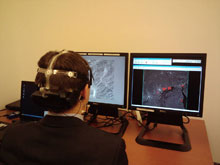Computers Get Help from the Human Brain
November 30, 2010 | Source: Technology Review

Columbia University researchers are using a BCI to help search rapidly through images. (Paul Sajda, Columbia University)
Columbia University researchers are using brain-computer interfaces (BCI) to help computers perform tasks they can’t manage on their own.
Electrical signals within the brain fire before a person even realizes he’s recognized an image as odd or unusual. So in experiments, the researchers used a BCI to sort through satellite images for surface-to-air missiles faster than any machine or human analyst could manage alone.
C3Vision (cortically coupled computer vision), uses an electroencephalogram (EEG) cap to monitor brain activity as the person wearing it is shown about 10 images per second. Machine-learning algorithms trained to detect the neurological signals that signify interest in an image are used to analyze this brain activity. By monitoring these signals, the system rapidly ranks the images in terms of how interesting they appear to the viewer. The search is then refined by retrieving other images that are similar to those with the highest rank.
The researchers have founded a spinoff company called Neuromatters to commercialize the technology, with $4.6 million in funding from the Defense Advanced Research Projects Agency. Along with military applications, possible applications might include advanced gaming interfaces and neuro-marketing.